- Technology selloff continues
- Yields’ trajectory suggest they are going higher
- Oil looks to be heading toward $63
Key Events
US futures on the Dow, S&P, NASDAQ and Russell 2000 plunged in trading ahead of the US open on Tuesday, along with European stocks as investors seem to be taking the view that the return of inflation, after a lengthy absence, is negative for markets.
Gold slid while the dollar rebounded.
Global Financial Affairs
Tech was the laggard as contracts on the NASDAQ slid almost 2% at one point on Tuesday morning. The underperformance of the tech sector, while smaller cap domestic firms take the lead, has been the formation for a reflation trade—where prices rise because of increasing demand and output.
Until recently the outperformance of technology stocks, while domestic stocks lagged, was driven by the view that we would remain in a pandemic fueled lockdown for some time.
The tech sector also led the declines in Europe, dragging the STOXX 600 lower for the second day in a row. On the other hand, energy related stocks, which have also benefited from the reflation trade, were higher.
Oil came within a cent of the $63 level for the first time since Jan. 3 2020 and a hair’s distance, less than 0.1%, from the highs of mid-2018.
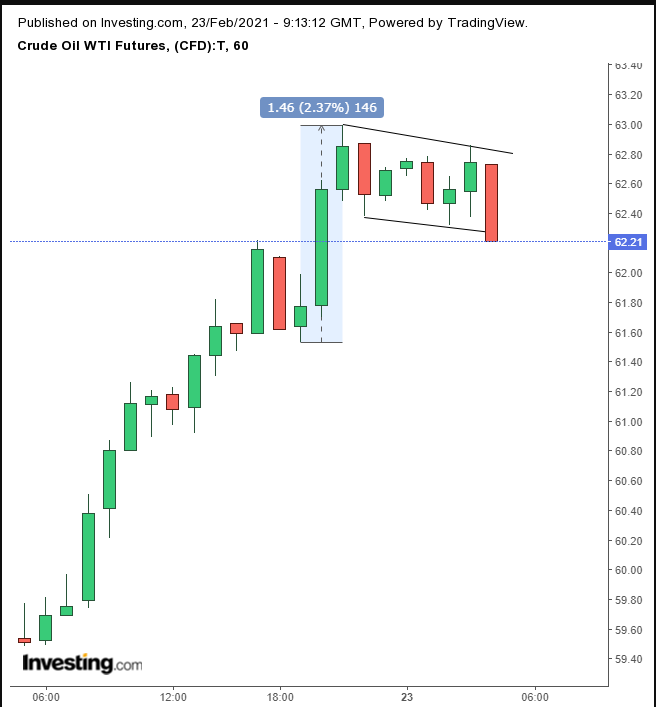
An upside breakout of an hourly falling flag carries with it a signal of the spike that repeated the breather investors took, with an implied target of overtaking the $64 mark. But, first, the pattern needs to complete an upside breakout, and right now, the price is testing whether enough bulls are willing to take over from earlier bulls, who cashed out on the 2.4% move in the three hours before equilibrium.
Another neglected sector during the pandemic that has gaining favor is banks. On Monday, shares of HSBC (NYSE:HSBC) jumped during the Wall Street session after the lender announced fourth quarter earnings that beat expectations.
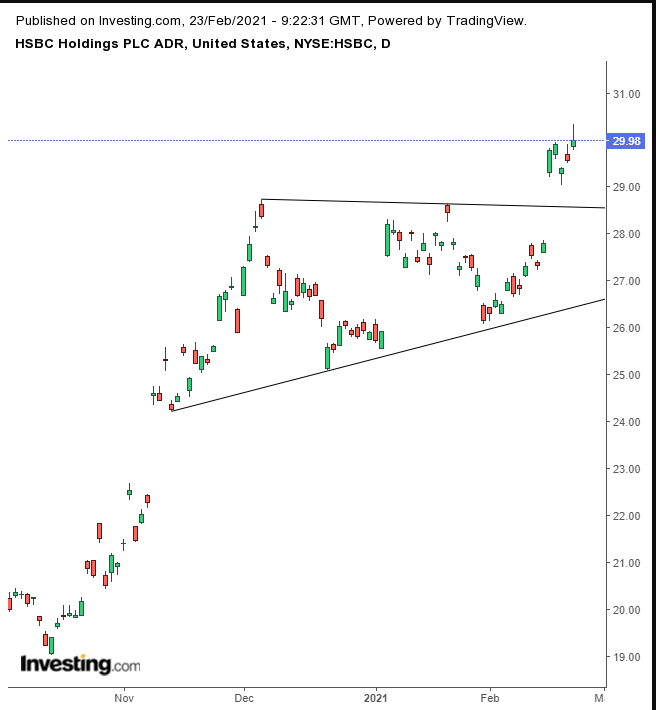
But markets can be incredibly capricious. In a rapid turnaround, this morning HSBC shares trading in London (LON:HSBA) slumped almost 3% after the global financial institution announced that annual profits fell sharply due to the worldwide pandemic.
Yesterday we explained why rising inflation is causing a market selloff, and today's slump in US futures is likely for the same reason.
However, there is an ongoing debate in markets over whether inflation will create a head or tailwind to a recovery. Nevertheless, in either scenario, the technology sector is not expected to perform well.
On Monday, the NASDAQ 100 sagged 2.5% to a three-week low, as rising inflation heightened traders' focus on big tech overvaluations. The S&P 500 index declined for the fifth day in a row, its longest in a year. However, energy and financial firms, two sectors that would benefit from a recovery, were higher.
Yields, including on the benchmark 10-year Treasury note, extended their advance for the eighth out of nine days.
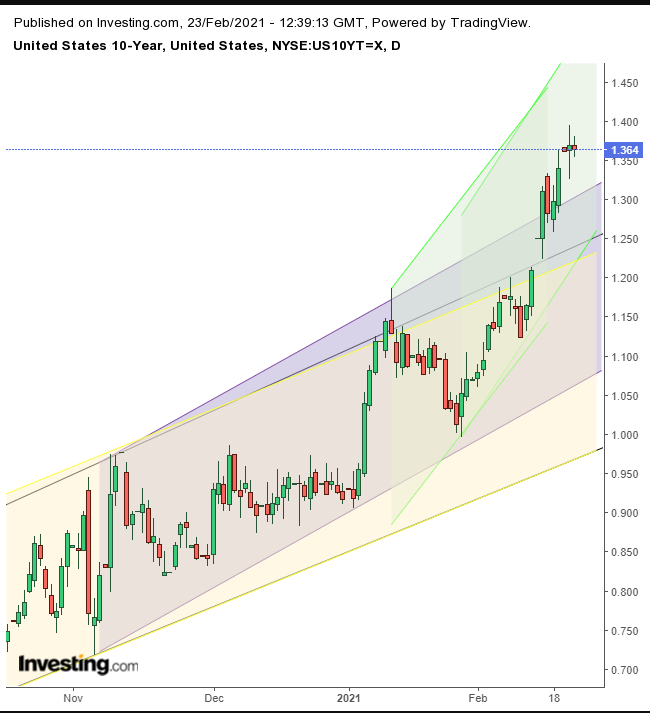
However, in the last three days, rates have ranged, after overcoming the top of a narrow rising channel, which has departed from the original rising channel since the August bottom.
The move suggests a continued advance—as investors keep selling off current Treasury notes in favor of future issues with higher rates, or other forms of haven assets, such as platinum.

The precious metal fell for the second day, trading within a pennant, considered bullish—upon an upside breakout—following the preceding spike, as the price struggles with the top of a rising channel.
Gold edged lower as well.
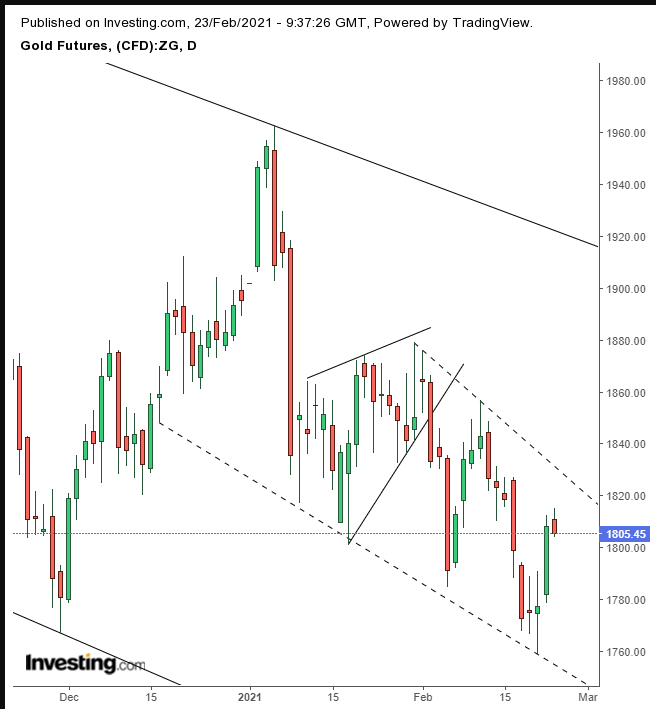
The yellow metal's drop occurred near the top of falling channel, following a bearish flag, within a larger falling channel since its March peak.
The dollar rebounded to the top of a falling wedge since its March high.
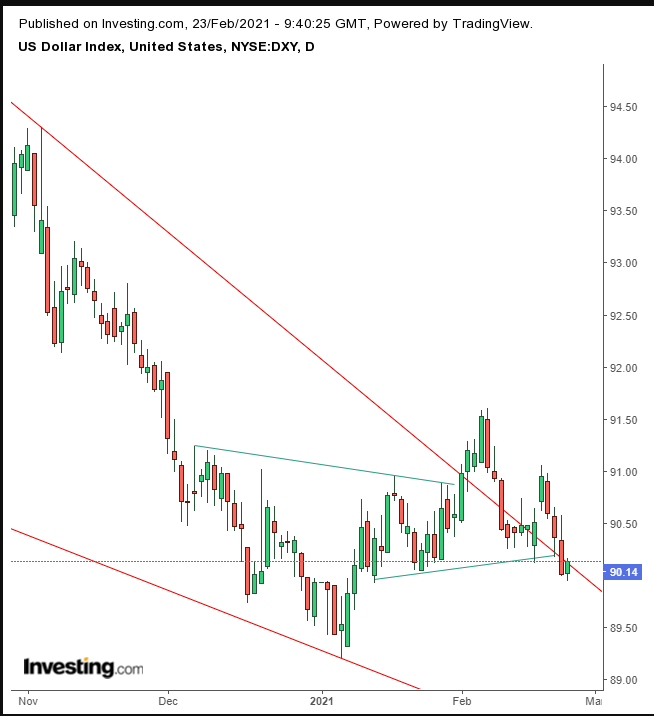
The greenback has been going crazy, creating back-to-back H&S, pointing in opposite directions. This kind of erratic activity jibes with the conflicting forces in play as the price nears its apex, putting the fire under traders’ feet to pick a side in which winner takes all.
Up Ahead
- Today, Chairman of the Federal Reserve, Jerome Powell delivers the central bank’s semi-annual monetary policy report to the Senate Banking Committee at 10am ET.
- EIA crude oil inventory report is out on Wednesday.
- Finance ministers and central bankers from the G-20, including new US Treasury Secretary, Janet Yellen, meet virtually on Friday.
Market Moves
Stocks
- Futures on the S&P 500 Index increased 0.1%.
- The Stoxx Europe 600 Index fell 1%.
- The MSCI Asia Pacific Index advanced 0.2%.
- The MSCI Emerging Markets Index climbed 0.1%.
Currencies
- The Dollar Index was rose more than 0.1% to 90.14.
- The euro was little changed at $1.2161.
- The British pound jumped 0.1% to $1.4081.
- The onshore yuan strengthened 0.1% to 6.461 per dollar.
- The Japanese yen weakened 0.1% to 105.20 per dollar.
Bonds
- The yield on 10-year Treasuries gained one basis point to 1.37%.
- The yield on two-year Treasuries dipped less than one basis point to 0.11%.
- Germany’s 10-year yield advanced three basis points to -0.31%.
- Britain’s 10-year yield jumped four basis points to 0.715%.
- Japan’s 10-year yield was unchanged at 0.125%.
Commodities
- West Texas Intermediate crude increased 1.7% to $62.74 a barrel.
- Brent crude gained 1.9% to $66.45 a barrel.
- Gold weakened 0.1% to $1,808.71 an ounce.
